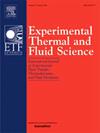高温连续气流中串联水滴对破袋及亚滴粒径分布的研究
IF 3.3
2区 工程技术
Q2 ENGINEERING, MECHANICAL
Experimental Thermal and Fluid Science
Pub Date : 2025-10-04
DOI:10.1016/j.expthermflusci.2025.111625
引用次数: 0
摘要
了解密集喷雾中液滴的相互作用机制需要对串联液滴对破碎进行研究。利用高速摄像机研究了在293 ~ 493 K气流温度下,分离距离(S)为1.9 ~ 13.3的串联水滴对的破碎现象和亚滴分布。分离距离是实际间距与液滴直径之比。在一定的临界分离距离内,铅滴破袋受尾滴碰撞的影响。铅滴破袋的临界分离距离随气流温度的升高而减小。分离距离和气流温度通过与铅滴的碰撞、铅滴的屏蔽作用和气流速度耗散影响尾滴袋破碎。进一步,通过将破铅液滴分为袋、边缘和节点三部分,分析破铅液滴的子液滴尺寸分布。控制袋状子液滴大小的相关长度主要取决于袋状厚度,而边缘和节点子液滴大小则取决于液环厚度。分离距离和气流温度通过改变袋状、边缘状和结状的体积分数及其相关长度来影响子液滴粒径分布。提出了一种基于不同部位(包、边缘和节点)的体积分数及其相关长度预测破铅液滴子液滴Sauter平均直径(SMD)的半经验模型。这些预测与本研究中广泛范围内的实验数据吻合得很好。该研究可为深入了解致密雾剂中液滴相互作用机理提供实验数据和理论参考。本文章由计算机程序翻译,如有差异,请以英文原文为准。
Investigation into the bag breakup and sub-droplet size distribution of tandem water droplet pair in an elevated-temperatures continuous airflow
Understanding droplet interaction mechanisms in dense sprays requires investigation of tandem droplet pair fragmentation. This investigation uses a high-speed camera to examine the fragmentation phenomena and sub-droplet distribution of tandem water droplet pair with separation distances (S) ranging from 1.9 to 13.3 under airflow temperatures between 293 K and 493 K. The separation distance is the ratio of the actual spacing to the droplet diameter. Within a critical separation distance, the bag breakup of the lead droplet is influenced by collision with the trailing droplet. The critical separation distance for the lead droplet bag breakup decreases with airflow temperature. Separation distance and airflow temperature influence the trailing droplet bag breakup through the collision with the lead droplet, the lead droplet shielding effect, and the airflow velocity dissipation. Further, the sub-droplet size distribution of the broken lead droplet is analyzed by dividing the broken droplet into three parts: bag, rim, and node. The correlation length governing the bag sub-droplet size primarily depends on the bag thickness, while the rim and node sub-droplet sizes depend on the liquid ring thickness. Separation distance and airflow temperature affect the sub-droplet size distributions by altering the volume fractions of the bag, rim, and node, as well as their correlation lengths. A semi-empirical model for predicting the Sauter mean diameter (SMD) of the sub-droplet of the broken lead droplet is proposed based on the volume fractions of different parts (bag, rim, and node) and their correlation lengths. The predictions align well with the experimental data among across a wide range in this investigation. This investigation can provide experimental data and theoretical references for understanding the droplet interaction mechanisms within dense sprays.
求助全文
通过发布文献求助,成功后即可免费获取论文全文。
去求助
来源期刊

Experimental Thermal and Fluid Science
工程技术-工程:机械
CiteScore
6.70
自引率
3.10%
发文量
159
审稿时长
34 days
期刊介绍:
Experimental Thermal and Fluid Science provides a forum for research emphasizing experimental work that enhances fundamental understanding of heat transfer, thermodynamics, and fluid mechanics. In addition to the principal areas of research, the journal covers research results in related fields, including combined heat and mass transfer, flows with phase transition, micro- and nano-scale systems, multiphase flow, combustion, radiative transfer, porous media, cryogenics, turbulence, and novel experimental techniques.
 求助内容:
求助内容: 应助结果提醒方式:
应助结果提醒方式:


